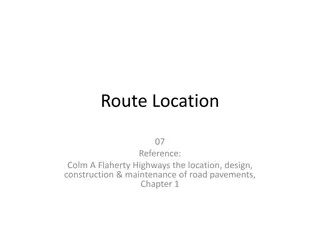Road Safety: Speeding
The dangers of speeding and why it's important to obey speed limits. Discover the impact of speed on stopping distances and the risks posed by rural roads. Follow the Two-Second Rule to maintain a safe following distance. Driving at a safe speed saves lives.
Download Presentation

Please find below an Image/Link to download the presentation.
The content on the website is provided AS IS for your information and personal use only. It may not be sold, licensed, or shared on other websites without obtaining consent from the author.If you encounter any issues during the download, it is possible that the publisher has removed the file from their server.
You are allowed to download the files provided on this website for personal or commercial use, subject to the condition that they are used lawfully. All files are the property of their respective owners.
The content on the website is provided AS IS for your information and personal use only. It may not be sold, licensed, or shared on other websites without obtaining consent from the author.
E N D
Presentation Transcript
Road Safety Speeding
Mistakes Speeding (Film) Some viewers may find this distressing.
Speed Limits Are Not Targets Speed limits are limits, not targets. When a car crashes, it s the amount of kinetic energy that the car has which determines the force of impact. Kinetic energy is the energy of motion. Small increases in speed lead to much higher increases in kinetic energy. When you re driving, it s hard to perceive that a slight increase in speed is really so damaging.. Crashes at higher speeds cause more severe injuries and deaths.
Rural Roads Are Not Racetracks Narrow, bendy roads often lack pavements or cycle paths and are unsuited to high speeds. Rural roads pose high risks, accounting for well over half of all fatal crashes. Speed is often a major factor in rural road crashes. A study showed a 10% increase in average speed results in a 30% increase in fatal and serious crashes. The most common crash types on rural roads are collisions at intersections, head-on collisions and running off the road.
Stopping Distances A vehicle travelling at 20mph would stop in time to avoid a child running out three car-lengths in front. The same vehicle travelling at 25mph would not be able to stop in time, and would hit the child at 18mph. This is roughly the same impact as a child falling from an upstairs window. Driving is unpredictable and if something unexpected happens on the road ahead, such as a child stepping out from between parked cars, it is a driver s speed that will determine whether they can stop in time and, if they can t stop, how hard they will hit. In adverse weather, such as icy roads stopping distance increases by up to 10 times.
The Two Second Rule The two-second rule is a rule of thumb by which a driver may maintain a safe trailing distance at any speed. The rule is that a driver should ideally stay at least two seconds behind any vehicle that is directly in front of his or her vehicle. Allow at least a two-second gap between you and the vehicle in front on roads carrying faster-moving traffic and in tunnels where visibility is reduced. The gap should be at least doubled on wet roads and increased still further on icy roads
Safe Speeds Saves Lives Driving at a safe speed reduces the risk of road death and injury A pedestrian hit at 30mph has a 1 in 5 chance of being killed. Every day, road crashes cause devastation to individuals, families and communities. With someone injured on a UK road every four minutes, and vehicle speed playing a part in every crash. Research has found that many young men are overconfident and take more risks.
Slower Driving is Safer The faster a vehicle is travelling, the longer it takes to stop. The faster we drive, the greater our risk of crashing. A crash at 30mph has twice the energy and destructive potential of a crash at 20mph. The greater the impact speed, the greater the chance of death. Where traffic is slow, more people choose to walk or cycle. 20mph is an appropriate maximum speed in places where people live.
Speeding Drivers Expect To Be caught Safe road users comply with road rules and share responsibility for the safety of everyone who uses roads. Most road deaths and injuries are caused by unsafe driver behaviour, often because drivers are going too fast for road conditions. Investment in roads policing and a comprehensive speed enforcement programme is essential to catch speeding drivers and deter people from speeding.
Speeding Penalties The minimum penalty for speeding is a 100 fine and 3 penalty points added to your licence. You could be disqualified from driving if you build up 12 or more penalty points within a period of 3 years. New drivers, still within 2 years of passing their driving test, will have their diving licence revoked (withdrawn), if they build up 6 or more penalty points. Please remember to drive safely, to protect yourself and others. Thank you.
Speeding Thank You Any Questions ?























